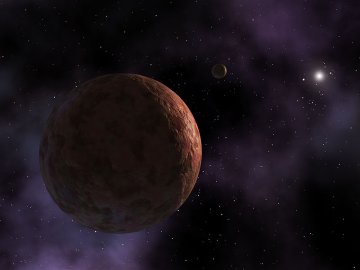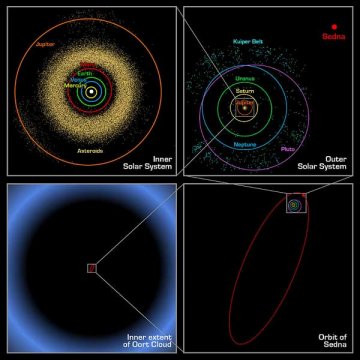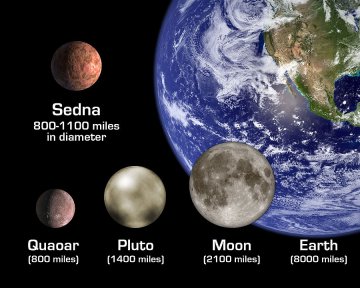Planets on the Edge
The discovery of a strange, planetlike object beyond Pluto adds to the puzzle of how the solar system formed.
By Emily Sohn
My Very Educated Mother Just Served Us Nine Pizzas.
Many kids use this short sentence (or something like it) to remember the names of the planets in order of their distance from the sun. The first letter of each word stands for a planet: Mercury, Venus, Earth, Mars, Jupiter, Saturn, Uranus, Neptune, Pluto.
But the solar system isn’t quite this simple. The more deeply astronomers look into the sky, the more mysterious and complicated our neighborhood becomes.
Besides the nine planets (and not everyone agrees that Pluto is truly a planet), at least two rings of chunky dust, ice, and rock orbit the sun. The asteroid belt sits between Mars and Jupiter. Another ring, called the Kuiper belt, hovers way out where Pluto orbits.
 |
|
Here’s how an artist imagines what Sedna, the most distant object known in the solar system, looks like. To the right of Sedna, about halfway to the white dot that indicates the sun, sits a faint object that may be a moon belonging to Sedna.
|
| NASA/JPL-Caltech/R. Hurt (SSC-Caltech). |
Surprises keep popping up in the remotest parts of the solar system. In March, astronomers from the California Institute of Technology announced that they had spotted a planetlike object even farther out than Pluto. Such discoveries are forcing scientists to revise their ideas about how planets form.
Fringe planetoid
The newly found object is named Sedna. It’s about three-quarters the size of Pluto.
Is it a true planet? It orbits the sun, but some astronomers say that even Pluto is too small to be called a planet. So, many researchers describe Sedna as a planetoid.
Sedna orbits in the coldest, most distant parts of the solar system, where temperatures drop to –240 degrees Celsius. This coldness accounts for its name. Sedna is an Inuit goddess who lives in a frigid cave deep in the Arctic Ocean.
Sedna looks funny, too. It’s bright red, like Mars. It’s also shiny. Other highly reflective planets are covered with ice, but Sedna doesn’t appear to have an icy surface. It may even have its own little moon.
And its orbit is wild. It takes more than 10,500 years for Sedna to go once around the sun, following a very stretched-out path. Sometimes, it’s as close to the sun as 75 times the distance from the sun to Earth. At other times, it can be as far away as about 1,000 times the distance from the sun to Earth. The other planets have orbits that are much closer to circular.
 |
|
Sedna has an unusual, stretched-out orbit (bottom right) far outside Pluto’s orbit (top right). Astronomers aren’t sure yet whether Sedna is part of the Oort cloud, which surrounds the solar system (bottom left).
|
| NASA/JPL-Caltech/R. Hunt (SSC-Caltech) |
“One of the questions is why Sedna has this crazy orbit,” says astronomer David Trilling of the University of Pennsylvania. “How did it get out there so far?”
Cloud or belt?
Sedna’s discoverers suggest that the planetoid belongs to a distant collection of icy objects known as the Oort cloud. More than 50 years ago, astronomers had predicted the existence of such a cloud at the edge of the solar system to account for certain kinds of comets that travel in enormous orbits that extend far beyond Pluto. Sedna may be the first sighting of an object belonging to this cloud.
Other astronomers aren’t so sure. They say that Sedna, like Pluto, belongs to the Kuiper belt. Sedna’s size, 1700 kilometers (or about 1,000 miles) across, makes it too big to belong to the Oort cloud, they argue. And there are known objects in the Kuiper belt that have orbits farther out than that of Sedna.
 |
|
Both Pluto and Sedna are smaller than Earth’s moon. Quaoar, which was discovered in 2002, resides in the Kuiper belt.
|
| NASA/JPL-Caltech/R. Hurt (SSC-Caltech). |
If astronomers can find more objects like Sedna, they may get a better understanding of how planets form and even how life began on Earth.
“If there is only one of these guys, you can pretty much make up any explanation you want,” Trilling says. “But if this Sedna guy is the tip of the iceberg for a whole bunch of other guys like it, maybe we’re missing something essential about how these guys formed.”
Theorists suggest that the formation of big planets, such as Jupiter, sent leftover material to the outskirts of the solar system billions of years ago. Icy comets later wandering in from these frigid regions may have delivered the first drops of water to Earth, Mars, and other planets.
Getting a sense of how many objects are out there, how many used to be out there, and how they move could help astronomers refine their theories. Such observations could also improve predictions about the likelihood of an asteroid or comet hitting Earth.
A closer look
To get a better idea of what’s going on, astronomers are taking a closer look at the Kuiper belt.
Some use ground telescopes to do enormous surveys of much of the sky. Robotic telescopes and computer programs analyze picture after picture until they detect slight movements of objects against the background of stars. This movement suggests the object belongs in the solar system. If anything interesting comes up, people take over the analysis. That’s how the Caltech researchers found Sedna.
Other scientists take a more focused approach. In one recent project, University of Pennsylvania astronomers used the Hubble Space Telescope to take a long, hard look at one tiny portion of the Kuiper belt. Their scan covered just one two-millionth of the sky. Their goal was to identify as many of the smallest, faintest objects as possible.
Because the Kuiper belt is so far away, the smallest objects the Hubble Space Telescope can detect are 20 kilometers across—about the diameter of Philadelphia. This may sound big, Trilling says, but the most powerful telescopes on the ground can only catch objects 100 times as big.
For a week and a half, the Penn team took pictures using the Hubble and stared at them around the clock. “When I close my eyes after doing this all day or all night, I see stars,” Trilling says. It’s as if he’s been punched, he says, “over and over again.”
Theorists had predicted that this particular region of the Kuiper belt would have about 85 small objects in it. At the end of the study, however, the astronomers turned up only three.
“One of our conclusions was that collisions among [Kuiper belt objects] must have occurred more often than previously suspected,” Trilling says. That would mean there are many more, really small objects that astronomers can’t see yet.
Lead researcher Gary Bernstein wants to do the same experiment again with another part of the Kuiper belt. He wants to make sure that the team didn’t happen to pick an unusual part of the belt.
Unfortunately, so many astronomers have projects that it’s hard to get time on the Hubble Space Telescope. The time pressure is even greater now that the National Aeronautics and Space Administration has decided to retire the telescope.
If you want a better look at the fringes of the solar system, you might have to wait another decade or two. NASA has plans to launch a spacecraft called New Horizons that will go to Pluto and beyond.
New Horizons is scheduled for launch in January 2006. It would swing past Jupiter to use that planet’s gravity to boost its speed. Scientific studies would begin in February 2007. The spacecraft would reach Pluto and its moon, Charon, in July 2015. It would then head deeper into the Kuiper belt to study one or more of the icy objects in that vast region.
From past experience, astronomers suspect that there’ll be lots more surprises.
Going Deeper:







